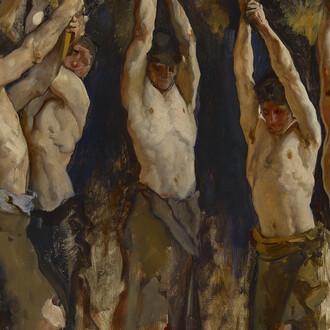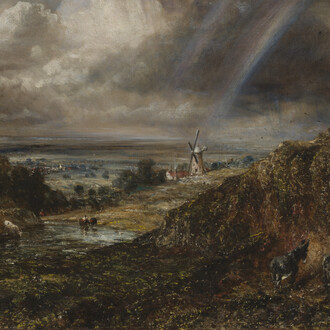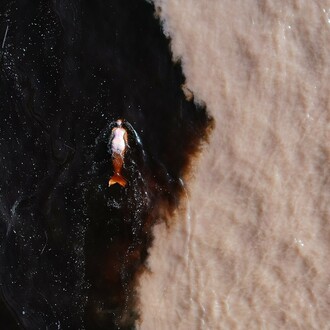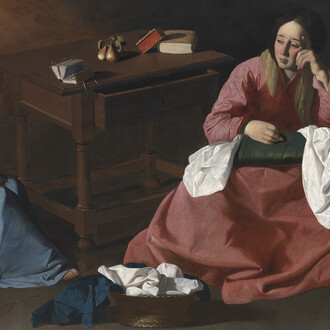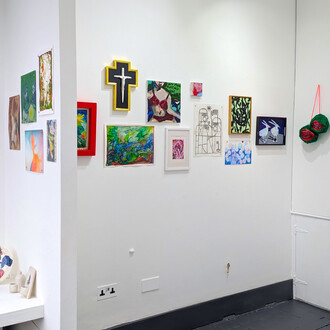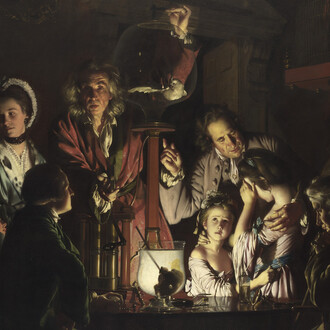Red Eight Gallery and Nina Churchill are proud to present Rediscovered geniuses: Juan Antonio Guirado and Igor Gorsky. This transatlantic exhibition sees London gallery Red Eight and New York City gallery Nina Churchill reveal a curated selection of previously unexhibited paintings from the Estates of Juan Antonio Guirado and Igor Gorsky.
Juan Antonio Guirado was a Spanish Surrealist artist who spent time in Australia and is considered Spain's leading master painter in the school of “Intrarealism”, and Igor Gorsky was a Greek Abstract Expressionist who moved to the USA and invented a unique pouring technique. Although Guirado and Gorsky never met, they were both Mediterraneans born in the same era, the politically volatile 1950s. Both artists, despite being overlooked in parts of their careers, created deeply introspective, visionary art that reflects an inner spiritual journey, combining abstraction with profound emotional and philosophical underpinnings.
Juan Antonio Guirado Espinosa was born in Los Villares (Jaen, Spain) in 1932 and his arts education began at the early age of 10 in Andalusia. He moved to Madrid at the age of 18 to study portraiture at the San Fernando Academy, later travelling to Italy and France studying Italian Renaissance and French Impressionism. In 1955 Guirado was commissioned to paint a series of murals in New York, and he had his first major exhibition in Miami in 1956. Guirado immigrated to Australia in the late 50s due to the social political climate, becoming interested in Oriental religions, in particular Hindu Philosophy Vedanta,which influenced his signature style.
He returned to his homeland of Spain in 1973 and became one of the most represented Spanish contemporary artists in museums and international collections that included King Hussein of Jordan, J.D. Salinger, and John Schlesinger, and by globally renowned museums including the National Museum Reina Sofia and the National Museum of Fine Arts in Valletta. He also received multiple awards including the gold medal at the El Grollo awards at the Venice Biennale in 1976 and honoured at the Malta Art Biennial for his prolific body of work.
Igor Gorsky’s path to becoming an Abstract Expressionist painter was extraordinary. Born George Vassilopoulos in Athens in 1936, he was an engineer, economics theorist and pioneering member of the think tank that created the Nasdaq securities exchange in 1971 and didn’t become an artist until the age of 52.
The decision to become an artist happened in 1988, when aged 52 he fell in love with Evita Myriam, a deeply spiritual Greek artist, who recognised his artistic talent. He soon developed an obsession with painting, working all night and developing a technique that involved boldly splashing and pouring car enamel onto canvas until he achieved the visual effects for which he was striving. “He moved like a ballet dancer, like Nureyev”, recalled Evita, “whom he had met when he was very young”.
Red Eight Gallery CEO Julian Usher explains: “Juan Antonio Guirado and Igor Gorsky share a connection through their deep exploration of cosmic and metaphysical themes. Both artists developed unique styles later in life, with Guirado’s Intrarealism focusing on the spiritual link between humans and the universe, and Gorsky’s abstract works, influenced by pouring techniques, expressing inner turmoil and sublime energy. This exhibition presents the first opportunity to purchase never seen before works from either artist at the beginning of their journey of rediscovery”.
The exhibition runs from 4th October to 14th November, 2024 at Red Eight Gallery in London’s historic Royal Exchange. There will be an invitation only VIP private view on 3rd October and Frieze Week VIP private view on 10th October.
Catalina Guirado, CEO of the Guirado Estate and daughter of Juan Antonio Guirado says: “I'm excited to return my father's art to London. He frequently exhibited here in the 1970s as one of Spain's most recognized painters of that era and it's my honour to continue the legacy. He was called the artist of the 21st century by the critics in the 70s with his visionary works that focused on man's greed, the destruction of the planet and spirituality- way ahead of his time and today's trend. The works I curated for this exhibition are from his 'vision' series 1990-2010 that focus on enlightenment as I hope that in these dark times we can all look to the light for a better future for mankind. He once said that the best way to view his work is with the third eye and I invite you to look inward as you enter the kaleidoscopic universes of Guirado's paintings”.
Nina Churchill is honoured to represent the never-before-seen works of Igor Gorsky, a long-lost master whose revolutionary techniques with enamel paints have positioned him as one of the Greats in abstract art. Gorsky’s work, celebrated for its explosive bursts of colour and vibrant energy, will be available for purchase for the first time at Red Eight Gallery during the exclusive exhibition, Rediscovered Geniuses. An epiphany led Igor Gorsky to discard his career and become wholly dedicated to painting. He succeeded in creating a new technique and style of pure pouring. Some paintings drive toward the sublime as sacred shafts of light. Others emit the hallucinatory energy of his inner mind.
Nina Churchill says: “This exhibition is not just about rediscovering forgotten artists; it’s about questioning why they were forgotten in the first place. It’s about resurrecting their voices and reinterpreting their influence through my own artistic lens”.
This exceptional showcase will reveal a Igor Gorsky collection that has remained hidden for decades. Gorsky’s unparalleled approach to enamel painting captures the essence of raw emotion and abstract beauty, marking him as a visionary whose genius was almost lost to history.
Evita Miriam, Art historian and former muse of Igor Gorsky remarks: “Igor Gorsky had an exceptional ability to make the past feel vibrant and relevant. In Rediscovered geniuses, his art bridges centuries with a unique voice, offering a fresh dialogue between tradition and modernity. His work reminds us that many talents have been lost to history, yet their essence remains ever-present and ready to inspire once more”.
Red Eight Gallery, located in the heart of London’s art district, is proud to host this landmark event, where art enthusiasts and collectors will be able to experience Gorsky and Guirado’s work in an intimate and inspiring setting. Red Eight Gallery and the Guirado Estate will present a curated selection of Juan Antonio Guirado paintings from his Visions series, which have never been exhibited before. This will be the first exhibition of Guirado in the UK since the 1980s. Juan Antonio Guirado is in the collection of the Reina Sofia Museum in Madrid, and Dame Francois Tempra, Director of the Malta Fine Art Museum described him as “The 21st Century Painter.”
Guirado’s Visions series ranges from the 1990’s and 2000’s to before his death in 2010, are regarded by critics and the artist himself as perhaps his finest works. On first appearances, one would say that we are gazing at abstract kaleidoscopic images of colour, but if we stop and pay attention, we soon discover the miracle surrounding their intimacy. We, as humans, are full of something divine, yet are scared of looking inside ourselves. When we look into Guirado's paintings we find the magic that will transport us to a wonderful spiritual world and will make us reflect on our cosmic existence.
Guirado's work opens the doors to the Universe, endless in its content and reflecting uncountable changes in parallel universes. Each single fraction of the painting itself is a reflection of the human being trying to understand the mystery of life to reach a calm spirit. His technique is superbly sensual for his oils have the fluidity of water colours in their silky, tactile quality and yet the contours of his visions have the definite, highly contrasted accuracy of the early masters of the Chiaroscuro. In sum, he is the fusion of both the renaissance and surrealist world. With his Intrarealist painting, Guirado fosters what could be called the ‘intravision’ or the vision of the self.
When asked to describe his paintings, Juan Antonio Guirado is quoted as saying: "I would describe it as an intra-realist painting. It is the type of painting that one has to see with the third eye, the eye of the mind".
Within the Spanish visual arts tradition of the 20th century, Guirado stands out as one of the few artists whose characteristic work stems from the concepts of Intrarealism. Intrarealism, a term coined by the ambassador, writer and Spanish pacifist, Salvador de Madariaga who wrote the manifesto for the movement that started in Barcelona in 1967 followed by an impressive who’s who in the arts at that time including Federico Fellini and J. D Salinger. Giurado is now considered one of the Spanish masters of the movement by art critics. It was in Intrarealism as well as in Oriental philosophy (Vedānta-Sūtra), which Guirado discovered whilst living in Australia, that he found the precepts with which he explored relevant themes that were fundamental elements of his work. Regarded as a ‘visionary’ painter by critics and journalists throughout his career, Guirado’s futuristic apocalyptic landscapes and his more spiritually uplifting paintings, often focusing on a tunnel of white light reflected his personal warning of man’s greed and destruction of the planet and contradictory quest for enlightenment from as long ago as the 1970’s way before it was the topic of everyday conversation.
Rediscovered geniuses: Juan Antonio Guirado and Igor Gorsky presents a rare opportunity to discover previously unseen paintings by two tortured geniuses.
Juan Antonio Guirado Espinosa was born in Los Villares (Jaen) in 1932 and his arts education began at the early age of 10 in Andalusia. At 18 he moved to Madrid to study portraiture at the San Fernando Academy, later travelling to Italy and France studying Italian Renaissance and French Impressionism. In 1955 Guirado was commissioned to paint a series of murals in New York, before returning to Spain. His work was discovered by American tourists whilst he made sketches on the streets of Madrid who turned out to be major collectors of the time and arranged for his first major exhibition in Miami in 1956. After returning to Spain, Guirado decided to immigrate to Australia in the late 50s due to the social political climate. It was there that he became interested in Oriental religions, specifically the Vedanta – one of the orthodox Hindu philosophies – which is greatly reflected in his paintings and where he created his signature style which prompted the start of his recognition as a Spanish - Australian painter with multiple exhibitions in Sydney.
On returning to his homeland of Spain in 1973 Guirado would live between London and Andalucia becoming one of the most represented Spanish contemporary artists in museums and international collections that included King Hussein of Jordan, J.D. Salinger, and John Schlesinger, and by globally renowned museums including the National Museum Reina Sofia and the National Museum of Fine Arts in Valletta. He also received multiple awards including the gold medal at the El Grollo awards at the Venice Biennale in 1976 and honoured at the Malta Art Biennial for his prolific body of work. At first he was associated with the Surrealist and Essentialism movement, exhibiting in Paris in 1978 alongside the most important Essentialist painters of the time, though in posterity he would consider himself closer to Intrarealism, a pictorial school with a great component of social consciousness and reflection on the world that surrounds the artist.
However, in Spain he made less of an impact for reasons unknown. His visionary paintings concerning ’Environmentalism’ which examined the destruction of the planet through mankind’s consumerism and endless pursuit of technological progress, at the expense of the environment was ahead of its time. For his 1996 exhibition in Almeria, art critic Manuel Quintanilla published a monograph on Guirado titled: The Contemporary Andalusian painter and although considered a master painter by those who knew his work Guirado continued to paint and exhibit only locally in Spain refusing to re join the ‘circus’ of the international circuit after much disillusionment.
In 2010 only a month before his 78th birthday, Guirado passed away in the place of his birth, Andalusia.The Guirado Estate was created by his only daughter, the British model and television personality Catalina Guirado, following his death. Over the last decade she has worked exclusively in the art world returning the Andalusian Maestro’s name to the art world with a series of critically acclaimed exhibitions in Madrid, Miami (to launch Art Miami and Art Basel) and at his birth city of Jaén where he was exhibited alongside the whose who of Spanish painters including Miro, Tapies and Picasso and placed in the prestigious Cesario Rodriguez Aguellerez Foundation collection belonging to the University of Jaén. Now she returns Guirado to London, his first exhibition since 1981, with the prestigious Red Eight Gallery.
Igor Gorsky’s path to becoming an abstract expressionist painter is extraordinary and unique. For the first 52 years of his life, he was not an artist. He was instead a brilliant engineer and an economics theorist. He had also been a pioneering member of the think tank that created the Nasdaq securities exchange in 1971. Moreover, he wasn’t Russian as his name would suggest but Greek — born George Vassilopoulos in Athens in 1936.
However, in 1988, at age 52, Vassilopoulos experienced an epiphany that completely transformed him into a painter. And it was no mid-life crisis. He had fallen in love with a deeply spiritual Greek artist, Evita Myriam, who was 29 years younger. She told him that she saw in him a huge fire of creativity and proclaimed that he had the potential to become a great artist. She gave him his first art supplies and was thereafter his muse and critic. Vassilopoulos was soon so obsessed with painting that he adopted the practice of working all night into the early morning hours, boldly splashing and pouring his chosen medium — car enamel — onto the canvas until he achieved the visual effects for which he was striving. “He moved like a ballet dancer, like Nureyev,” recalled Evita, “whom he had met when he was very young”.
Eventually, friends commented on the boldly expressive paintings that were hanging in his apartment and asked who created them. Still somewhat insecure because he was a guileless new artist with no training, he contrived the story that the paintings were not his but those of a Russian painter he had met by the name of Igor Gorsky. Also, being new to the game, he felt an assumed name would assure he received honest feedback instead of honeyed words. The source of this Russian brush name was Evita, who had described to him a dream she had about a man in a monastery who lived with a vicious wolf he had tamed. Later, she realized that her dream had summoned the Wolf of Gubbio that St. Francis of Assisi had tamed. But when she woke up from the dream and tried to recall the name of a wolf from a Dostoyevsky novel — likely because both she and Vassilopoulos were very familiar with his writings. However, she mistakenly said it was “Igor” only because the name of the Russian composer Igor Stravinsky had quickly come to mind. When Evita described her dream’s tragic ending for the wolf, George wept. In that moment of dramatic empathy he declared that the name, Igor, must be his own. He then chose the surname of Gorsky simply because he felt its alliteration with Igor was fitting. From that point on, George Vassilopoulos was completely transformed in his rebirth as Igor Gorsky. He even took the step of legally changing his birth name to his adopted brush name. The origin of the name change is important to the end of this story because Evita’s creative path, which would lead her to become an Arhatic yogi, was always based on the prayer of St Francis of Assisi.
Gorsky was born in Athens in 1936 and grew up in a seaside suburb during the Great Depression. His father was an attorney, who during World War II forged passports for Jews and helped them escape from occupied Greece. His mother’s nickname was “the General” because of a strong character that would not tolerate vulgarity or frivolity, and her ethics were impeccable. Blonde and blue-eyed, she exuded a regal presence — an important asset when her son was a youth.
As a teenager, he was known as irreverent and controversial. He once found a discarded World War II revolver in the fields and brought it to school. His favourite way to attract a crowd was to arrive on horseback at a chic cafe, earning a nickname from the girls — “George-on-the-horse.” He could provoke shock at a formal dinner when, after eating crabs and lobster, he would clean his fingers in the provided bowl of water — and then drink it to everyone’s disgust.
Despite his rebellious stage as a teenager, he was a brilliant student during the five-year program at the highly selective National Technical University of Athens, known as the Athens Polytechnic. After graduating, he travelled to Austin where, in 1963, he entered the four-year Masters program in Chemical Engineering at the University of Texas. He graduated in 1966 but not before marrying Tralene Bailey, a fine art major in her junior year at the university. It was also around this time when he was recruited by two of the university’s professors — Franco Modigliani and Andrew C. Stedry — to join a think tank whose research into economic theory and consumer behaviour in the stock market played a significant role in the creation of the Nasdaq securities exchange in 1971.1 Vassilopoulos’ expertise in chemical engineering quickly landed him a job with an oil refinery in Houston, and by the early 1970s he left to form a partnership that manufactured air conditioning systems for huge refineries in Saudi Arabia. After six years of focused work, he succeeded in making enough money that would last his lifetime.
Although the unexpected rebirth of the engineer George Vassilopoulos into the painter Igor Gorsky would be decades away, he was also interested in the surrealist approach in his wife’s paintings. She had always thought of him as a genius in mathematics, so she was surprised by his effusive encouragement when she had once suddenly decided to give up painting. “George, in his very demonstrative way, raised both of his hands in the air, fingers outspread as if to catch the light and throw it toward me”, she recalled, “He then gestured as he yelled, ‘Paint! Paint!’ On one occasion I yelled back at him, ‘Oh, if you want me to paint so bad, why don’t you paint?!’” When that marriage ended in divorce in 1983, Gorsky returned to Greece where he became even more passionate about the world stock exchanges.





